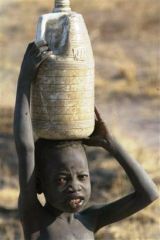FACTBOX-Sudan, one of Africa’s neediest cases
LONDON, April 11 (Reuters) – At a meeting which opens on Monday in Oslo, Sudan will ask international donors for $2.6 billion to rebuild itself following the end of Africa’s longest civil war.

|
|
A Sudanese boy carries water in a plastic container Tuesday, Jan. 18, 2005 in Rumbek in southern Sudan. |
Sudan says it will need $7.8 billion up to Dec. 2007, but will fund much of this from oil revenues.
Following are some key facts on the south of the country where war raged for 21 years.
POVERTY:
* Poverty rate in the south is about 90 percent (50 percent in north).
* Sudan is ranked 139th out of 177 countries on the United Nations Development Programme’s human development index. The HDI focuses on three measurable dimensions of human development: living a long and healthy life, being educated and having a decent standard of living.
* The HPI-1 – which measures human poverty in developing countries – values Sudan at 31.6 percent, which ranks the country 51st among 95 developing countries for which the index has been calculated.
FOOD:
* One in three people in the south rely on food aid.
* Chronic malnutrition among the under fives is 48 percent in the south (35 percent in the north).
* Although the south is primarily dependent on subsistence agriculture about 47 percent of households do not have livestock.
HEALTH:
* One in four children born in southern Sudan die before the age of five, 48 percent from water related diseases.
* Children in Sudan have a mere 25 percent chance of living to 65.
* There is less than one doctor per 100,000 people in the south (1 to 2 in Darfur and 25 in Kenya).
* Sudan is one of the few countries to have seen access to safe water decline in the past decade. Many rural people pay as much as half their family income on water, often of dubious quality.
EDUCATION:
* In 2003 only 20 percent of children enrolled in school in the south, of which girls accounted for only one in four. As many as half do not continue beyond the first grade.
* Literacy rate for the 15-24 age group is 31 percent (78 percent in the north). Literacy among young women in the south is 16 percent. A woman in southern Sudan is many more times likely to die in childbirth than to finish eight years of school.
INFRASTRUCTURE:
* There are no tarmac roads in the south. Rail connections between the north and south are largely out of service.
* Only about 15 percent of people in the country have access to electricity.
(Sources: Framework for Sustained Peace, Development and Poverty Eradication, the development blueprint drawn up by Sudan’s Joint Assessment Mission/U.N. Development Programme – http://hdrundp.org)
